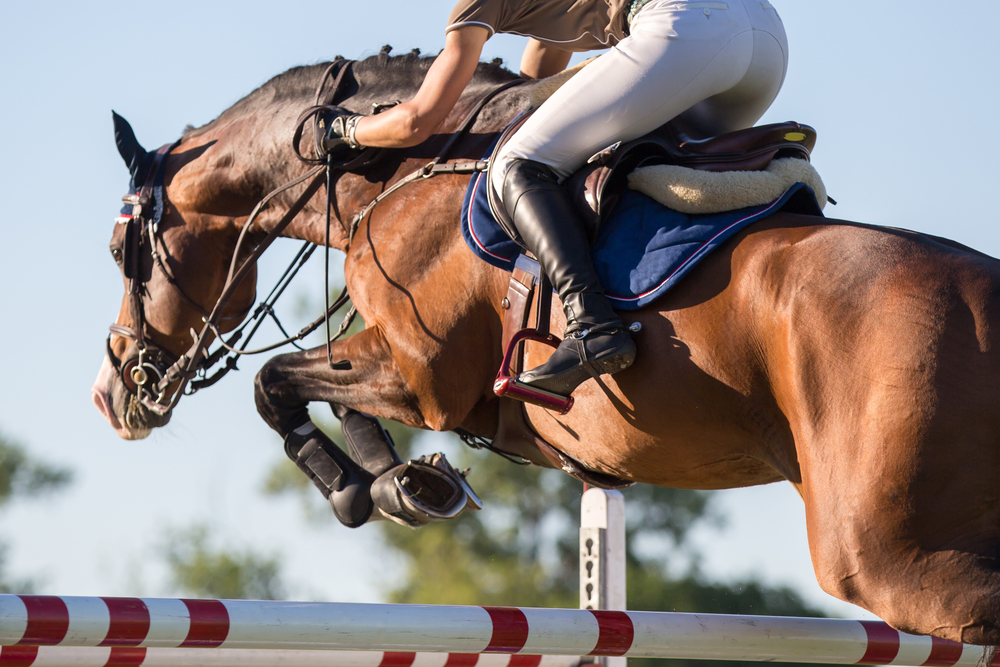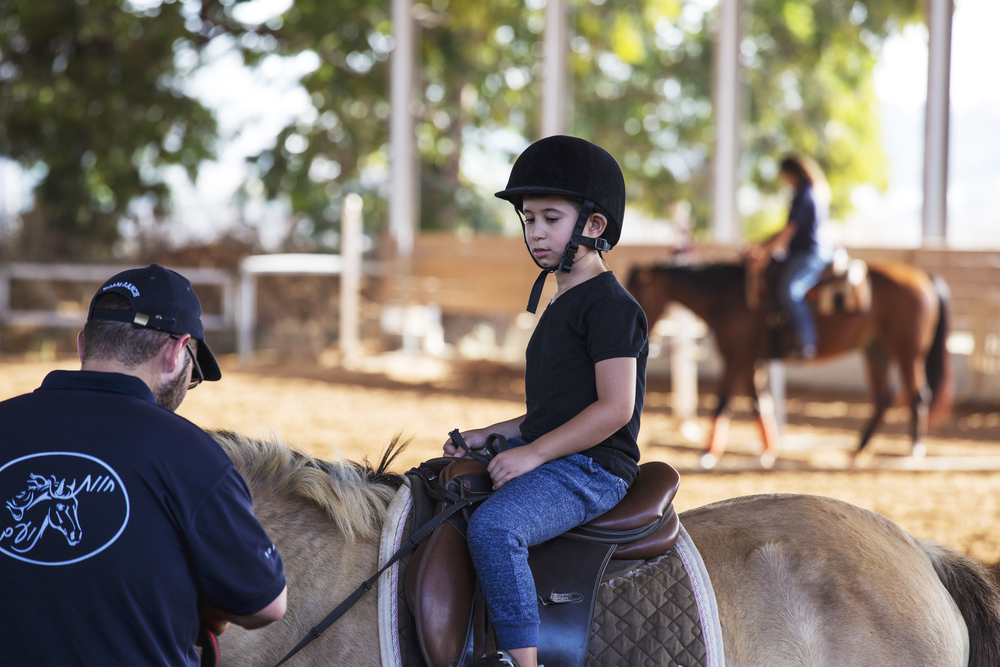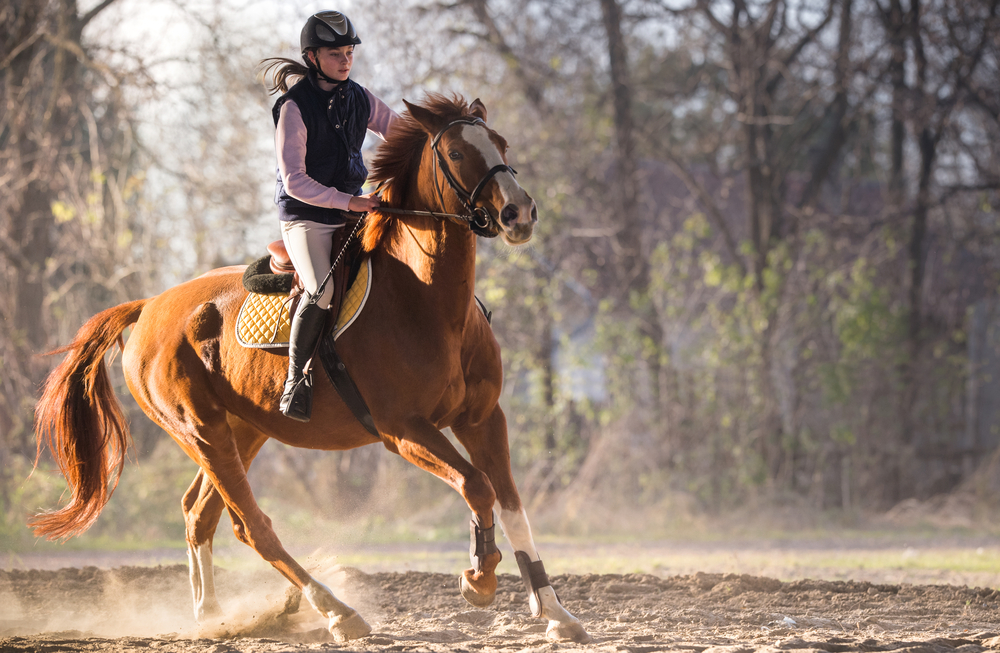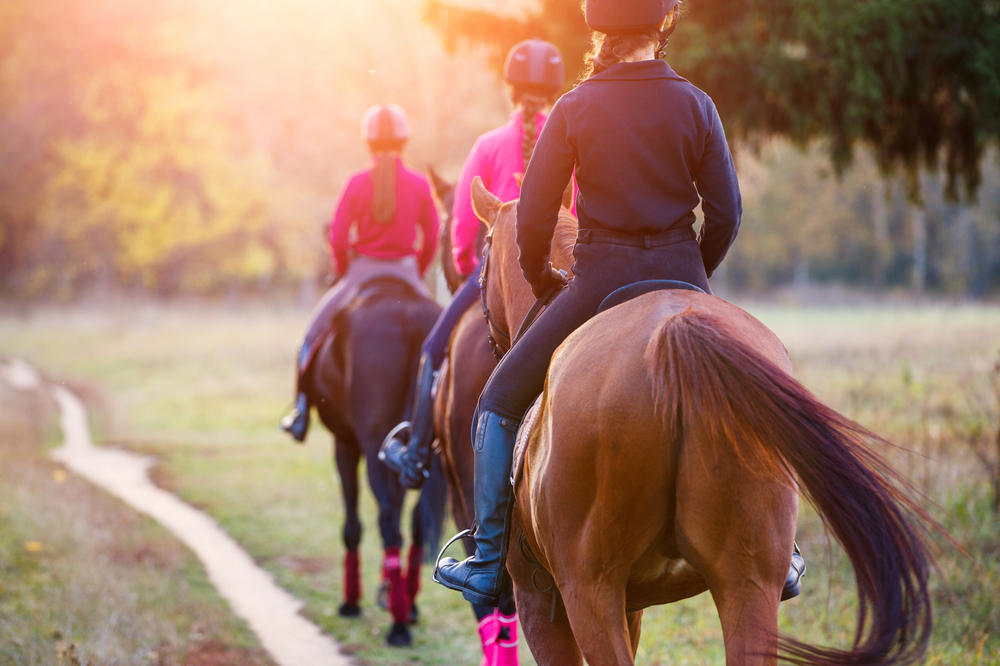- Your source for stall mats, rubber arena footing, arena harrows and arena dust control.

If you are interested in improving your showjumping skills or learning something completely new in partnership with your horse, you might like to attend a showjumping clinic. But what is a showjumping clinic?
Showjumping clinics are usually a one or three-day riding event organized by a riding school or a horse-riding instructor at a specific venue. It is a group of riders and horses attending a training session with a certified riding instructor specializing in show jumping. Lessons focus on improving your jumping technique, approach to jumps, and all other aspects of show jumping.
Let’s find out what showjumping clinics are all about and what happens at a showjumping clinic.
Explaining training clinics
Training clinics are organized in all riding disciplines to teach riders and horses. Horse-riding training clinics can be held throughout the year at any venue that caters for horse riding, like riding schools, private stables, farms or show grounds.
Clinics offer the opportunity to get out and about with your horse while learning from different instructors and using facilities you probably don’t have access to at home. You are able to meet fellow riders and make new friends.
A training clinic can be held on the day or be held on a couple of consecutive days. There are different training clinics tailored for a specific horse-riding discipline that you can attend depending on your level of experience and riding skills.
At each training, the clinic has a certified instructor present to teach the lessons and assist riders.
Show Jumping clinics
Showjumping training clinics focus mainly on teaching the show jumping discipline. There are different jumping clinics available to attend, from intermediate to advanced levels of riders. Showjumping clinics are an excellent fun way to improve your jumping skills and knowledge through a variety of fun riding experiences while interacting with a group of riders.
The number of participants at a showjumping clinic is usually kept small to ensure each rider will receive one-on-one attention from the instructor.
What do you need to do to prepare for a showjumping clinic?
Going to a showjumping clinic is an investment in time and money, and you want to get the best out of it for you and your horse. The better you prepare yourself and your horse, the more you will enjoy the experience.
There are some unwritten rules and etiquette about the clinic that everyone needs to be aware of and try to follow.
- Prepare your horse in advance.
- Prepare your equipment and tack properly.
- Prepare yourself.
- Accept responsibility.
Prepare your horse
Start working on your horse’s fitness in advance before attending a clinic. Your horse does not have to be 100 percent fit, but a certain fitness level will make the whole experience so much more enjoyable.
Horses can experience colic after strenuous exercise after a layoff, so make sure your horse is fit enough to compete.
The risk of short- and long-term injury to your horse is high if your horse is not adequately fit to attend a showjumping clinic.
Practice some pole work and focus on your strengths and weaknesses. Knowing your weaknesses and strengths will help you when asked what area you want to work on at the clinic. At the clinic, ask to work on your weaknesses rather than your strengths.
Groom your horse; not all horses are equal in beauty or oil paintings, but if your horse is neat and tidy, washed and groomed, it shows you respect and cares about your horse.
Prepare and ready your equipment
When it comes to your horse’s equipment, clean and oil all your tack like preparing for a show, check all your tack and buckles for any defects. There is nothing like a piece of tack breaking during a riding lesson to embarrass a rider and hold up the whole class.
Pack an extra halter and a few bits and bobs you might need just in case you need to replace a piece of tack with a faulty or snapped buckle.
It is probably a good idea to ride in the riding gear you have used before and know it fits. Now is not the time to be flashy and bring out all the bling, and it might end up not fitting properly and cause discomfort.
Pack your own water and feeding buckets even if you might not need them. Better to be prepared than to be sorry afterward. Ask if there is water available or if you should bring your own. Find out if they offer a stall or stable area where you can safely keep your horse.
Make sure you pack your brushing and tendon horse boots. You are going to be asking your horse to move in unfamiliar ways. Best be prepared and protect your horse’s legs if your horse knocks himself on a pole and hurts his legs.

What essentials do you need to take along to the showjumping clinic?
Packing for a show jumping clinic can be chaotic and stressful. Make sure you pack everything you need. It’s probably happened to a few riders at least once and possibly more often than they care to admit. You get to a horse show or riding clinic just to discover you have left behind some essential piece of equipment or supplies.
It’s very frustrating to realize you forgot something important, and it is a good idea to make a packing list that you can laminate and keep for future training clinics.
Essential paperwork
- Most importantly, pack your horse’s vaccination passport. Proof of negative Coggins should also be presented at the clinic.
- Pack your identification and registration papers and proof of payment.
- Emergency contact numbers of relatives or friends in case of an injury.
- Cash in case of last-minute fees that you did not calculate.
First Aid kit
While we all hope and pray that our horses don’t get injured while attending a showjumping clinic, it is essential to take a first aid kit along.
- Disinfectant.
- Gauze pads.
- Blunt-ended scissors.
- Vetwrap or other non-stick bandages.
- Thermometer
- Bute or any other anti-inflammatory medication.
- Syringes.
- Electrolytes.
Grooming kit
First impressions are very important, and presenting yourself with a clean horse well fitted with the correct riding gear will show you care for your horse, respect, and seriousness about your riding. To keep your horse clean during a showjumping clinic, pack a proper grooming kit.
- Brushes and combs.
- Hoof Pick
- A small towel to remove dust in between lessons.
- Mane comb
- Braiding elastic bands.
- Fly repellent spray.
- Sponge
Trailer traveling kit
There are a few items that should always travel in the trailer when attending show jumping clinics.
- Spare halter and lead in case anything decide to break.
- Water and Feeding buckets.
- Hay net.
- Hay and horse feed.
- Treats for your horse, but be sure not to feed any treats to your horse before any lesson, or you might end up with frothy slobber all over your breeches.
- Traveling boots and wraps for your horse.
- A head bumper to protect your horse from bumping his head when traveling.
Horse tack
- Halter and lead rope.
- Bridle. Make sure your bit is clean.
- Spare reins. (in case the worst happen)
- Saddle, clean saddle pad and girth.
- Spare stirrup leathers (in case one break).
- Hole punch (in case you need to adjust anything).
- Protective boots for your horse. (Brushing and tendon boots).
- All-weather horse blanket.
Rider’s kit
- Boots. Take a used pair of riding boots; if you are taking a new pain, wear them in first, or you could be in a lot of pain at the end of the day.
- Jodhpur’s/Breeches. If you have a spare, take them.
- Polo shirt. Clean one for each day.
- Helmet and gloves.
- Jacket. (in case it gets cold).
- Hair ties. Your hair should be neatly tied back.
- Safety pins for attaching numbers to your shirt.
These are some miscellaneous items to take along to the showjumping clinic to be prepared for any situation that might arise.
- Wet wipes for face and hands in between lessons.
- Drinking water bottle.
- Aspiring or anti-inflammatory medication for when a headache pops up.
- A folding chair will make rest time in between lessons more comfortable.
- Snacks for yourself. Pack a cooler box with cool drinks and healthy snacks for yourself to eat.
- Sunscreen.
- Hat.
- Toilet paper. Don’t leave home without it.
- Take some extra cash in case of an emergency.
- Small sewing kit in case you need to make any repairs.

Prepare yourself properly
Do your research
Before you attend the showjumping clinic, do your research. Research the instructor, how they conduct their clinics and their approach to riding. If the instructor has any videos on YouTube or published books out, have a look and familiarize yourself with that instructor’s techniques.
Doing some research beforehand will give you valuable insight into what the instructor expects of his students during lessons. You can also evaluate what other riders generally wear and what gear you need for your horse.
Reach out to other riders that have been to a showjumping clinic and get some tips and information from them. Most horse-riders will gladly advise a fellow rider.
Dress correctly
As a general rule attending a showjumping clinic, you should dress appropriately by wearing the right riding clothes as if you are attending a show.
Your riding clothes should be clean and fitting correctly. While it is not expected of you to wear the latest fashionable expensive riding apparel, you are expected to wear jodhpurs with riding boots and a well-fitting polo shirt.
Tie your hair neatly back, and your riding helmet should fit tightly on your head. The way you present yourself shows how serious you are about your training and riding.
Be openminded
Keep an open mind, and don’t refuse even to attempt what the instructor is asking you to do. Make the most of your teaching experience by trying your best at what they are trying to teach you.
Accept and expect that both you and your horse will be asked to work outside your comfort zone.
Be physically prepared
Be prepared; often, the instructor will ask you and your horse to perform a task that might be physically challenging to you both don’t give up. If your horse finds it hard to understand the aid or task asked of him, take a break and start again. You should be fit enough to persevere and stick it out.
Be mentally prepared
You need to be mentally prepared; riding in a training clinic can be mentally taxing. If you are feeling anxious or overwhelmed, it might not be a good idea to ride in a showjumping clinic. There can be a lot of added stresses when learning new things.
If you are feeling nervous during a clinic, let your instructor know, he can help you through your fears and settle your nerves. No matter how famous and experienced they are, they are humans too and want you to succeed and reach your goals.
Be honest
Make sure you fill out your entry form honestly when describing your experience and level of expertise. It is frustrating to everyone if the group has a marked disparity between the rider’s levels.
If your instructor asks you if you felt what you did that made your horse perform better, don’t just say yes if you didn’t feel it. You are at the clinic to learn, so ask questions if you don’t understand exactly what is being requested of you.
Be on time
There is nothing worse than being late and having a whole bunch of riders and horses stand around waiting for a late arrival. Arriving late is disrespectful to everyone attending the clinic. If you do arrive late due to unforeseen circumstances, apologize and try to catch up as quickly as possible.
Arrive early and watch the other lessons
Arriving early at the clinic will really help your lesson go well, as most instructors have a theme for the day. If you watched the previous lesson, you will know what is expected of you from the instructor and be prepared for any pitfalls.
Watching other riders in lessons will increase your learning by double. You may even be of assistance to the instructor when the lesson involves poles or jumps.
Respect other rider’s space
Follow and familiarize yourself with the riding etiquette within a riding arena. Like passing left to left and circling away when you get too close to the other riders. Don’t stop and stand your horse right on top of another horse while waiting for your turn.
If you need to dismount and adjust tack at any time, try to time it so that you do it while it’s another rider’s turn and not waste any of the instructor’s time while you are in the arena.
Respect the venue
Only use designated areas for warming up, and don’t muck out your trailer in the parking lot. Don’t use other people’s cleaning kit or equipment. Clean up after your horse and dog. Don’t leave any trash lying around.
Be quiet
When you arrive early, it is important to observe quietly and not do anything to distract the riders, horses or the instructor. Take any chit-chat away from the lesson, and it can be challenging to hear the instructor from 50 or 60 meters away without a group of spectators chirping away from the sidelines.
It is accepted to comment but keeps your comments quiet and hushed as not to disturb the riders. Laughing and being loud is disrespectful to the riders and instructor.
Noisy spectators can be very distracting to riders to hear laughing while they wonder if they did anything wrong.
Be respectful
While spectating, be respectful keep your comments positive. Be mindful of what you say; a rider’s friend or family can be sitting next to you and probably hear your comments. Imagine it’s you on the horse and in the lesson, would you want someone to be loud and disrespectful while you are in a lesson?

Accept responsibility
The welfare of your horse
Always put your horse first. Make sure your horse’s needs are met and that he gets adequate rest between lessons. If you feel that your horse is stressed physically or mentally, speak up, don’t hand your horse’s welfare over to someone else.
If you have to stay over at the clinic and it is the end of the day, take care of your horse first, make sure your horse is groomed, stabled, watered and fed before you do anything else. Your horse’s needs come before anything else.
What if you can’t attend?
It is expected to pay for your entry even before you attend. If anything comes up and you are unable to attend, let the organizers know as soon as possible. Letting the organizers know that you cannot attend will allow your slot to be given to someone on the waiting list.
Accommodation and airfare costs spent by the organizers won’t go to waste, and you might get a full refund in the end. If you are a no-show at the clinic and haven’t yet paid, expect to be contacted for the fee and blacklisted from future clinics.
The don’ts
Don’t think you know best; you are there to learn, so follow instructions even if you think 30 minutes of trotting poles and perfecting your outline in a walk is a waste of time.
Don’t be greedy; we all want to do extra jumps and have more time with the instructor.
Don’t start jumping random fences or get your instructor involved in a lengthy conversation about all your individual riding problems.
Don’t let your horse get cold while standing still waiting for your turn at the exercise.
Don’t attend a clinic with a green horse. Try to get some individual training lessons booked before you attend a clinic with a completely green horse that has never trotted over poles or attempted a jump.
What does it cost to attend a showjumping clinic?
The fees to a showjumping clinic may vary; it depends if accommodation or airfare is included in the fee. Showjumping clinics held in your immediate area might be less expensive. It also depends on if it is a one-day or three-day event.
Stabling fees could be extra and calculated by the organizers of the event. Be sure to check if there are any hidden additional costs that you might not have known about. This may vary, but usually, shavings are available at $10 per bag.
Usually, the fees for a show jumping clinic are:
- Deposit $200 needed to secure your booking.
- One day event $250
- Three-day event. $675
What does a showjumping clinic lesson schedule look like?
Showjumping clinics don’t all look the same, and some instructors focus on different themes and times of the day. However, you can expect a general day at a showjumping clinic to look a bit like this:
- 8 am. Session 1. Green horse
- 1 pm. Session 3. Intermediate high. 2’9″- 3’3″ (1.0m)
Only 8 riders per session are allowed. A total of a maximum of 32 horse/riders combination allowed.
What training exercises can I expect at a showjumping clinic?
At showjumping clinics during the flatwork phase, you can expect to learn about transitions. Riders work on transitions from trot to canter, canter to trot, straight lines or smaller circles working towards connection.
Expect to do some pole work on the ground before any jumping will take place. These ground exercises help improve the horse’s balance, coordination, suppleness, rhythm and reactions to the aids.
An instructor will have planned a list of training exercises to be completed on the day or over the three-day event. These training exercises are fun for horse and rider and help to improve rider coordination and focus.
You will be asked by the instructor to do some jumping exercises, and when the time comes to start jumping, the focus is placed on where to ride and how to ride at a jump working on your approach, control and jumping technique.
Showjumping clinics are designed to teach riders a stable, correct and balanced position between and over jumps, with good control of line and rhythm.
Depending on the level of the clinic, the rider will learn and do the following exercises:
- The rider will learn to improve his jumping technique through the use of the grid and groundwork.
- The riders will learn about a horse’s technique in jumping through loose schooling.
- The rider will learn about Riding theory, understanding strides and distances.
- A complete session devoted to Jumping a course.
What vaccinations does my horse need to attend a showjumping clinic?
Your horse should always travel with his vaccination passport. Your horse should be up to date with all his annual vaccines to attend any showjumping clinic.
All horses attending the showjumping clinic must have received their latest booster vaccination within twelve months. All attending horses should have a compliant vaccination history.
Vaccination passports will be checked upon arrival for compliance, and those that do not comply will be denied access to the showjumping clinic and all facilities.
It is strongly recommended that horses attending the showjumping clinic have a booster even if the horse’s last vaccination was more than six months ago. No booster should have been given seven days before the clinic.
Insurance cover
The organizers might ask you to sign a waiver, indemnification or medical treatment authorization form at the showjumping clinic. Make sure your insurance cover is up to date and covers all aspects of your horse-riding activities before you attend a showjumping clinic.
Make sure all your emergency contact details are listed on your application or entry form so that someone would be able to contact your relatives in the unfortunate event of an injury.
Conclusion
Showjumping clinics are a way to improve your jumping technique and learn from a certified, experienced instructor while meeting up with fellow riders.
Clinics are an excellent opportunity for first-time jumpers to gain experience in a non-competitive atmosphere.
Whether you are preparing for a show or just want to improve your jumping technique attending a showjumping clinic will give you the foundation for fun and successful jumping in the future.
You will learn how to balance in the fluid, non-interfering position at a showjumping clinic and maintain a fine-tuned connection with your horse while jumping over obstacles.
Instructors with decades worth of experience of riding at top levels will teach and guide you to successfully reach your jumping goals.
You will gain experience judging your approach distances at the clinic and be confident in steering your horse over each jump.
It doesn’t matter what your level of riding or is, and there is a clinic to attend for every level of rider from beginner to advanced.

